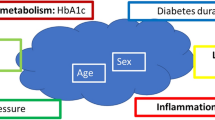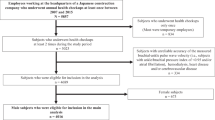Abstract
Arterial stiffening is the major cause of increasing systolic blood pressure in arterial hypertension. Increased arterial stiffness is one major mechanism responsible for morbidity and mortality in hypertension. A C825T polymorphism was identified in the gene encoding the G-protein β3 subunit (GNB3), and an association of the T-allele with hypertension was demonstrated in several studies. In order to identify a pathogenetic link between hypertension and arterial stiffness, we compared two indices of arterial stiffness, pulse wave velocity (PWV) and augmentation index, in young, healthy men with and without the 825T-allele under resting conditions. PWV was determined from pressure tracing over carotid and femoral arteries in 99 subjects (CC: n=43; CT&TT: n=56). Augmentation index was derived in 72 subjects (CC: n=30; CT&TT: n=42) by pulse wave analysis using radial applanation tonometry. Carriers of the 825T-allele exhibited a significantly higher PWV compared to subjects with the CC genotype (6.0±0.1 m/s (TC&TT) vs 5.7±0.1 m/s (CC); P=0.0251). There was also a significant difference (P = 0.0448) in augmentation index between carriers of the T-allele (CT&TT: 3.4±2.9%) and controls with the CC -genotype (−5.0±4.1 %). There was no difference in any other anthropometric (age, height, weight, body mass index) or haemodynamic (heart rate, peripheral and central blood pressure). In summary, the C825T polymorphism is associated with higher arterial stiffness in young, healthy males. Arterial stiffening may pathogenetically contribute to the development of hypertension in carriers of the T-allele.
This is a preview of subscription content, access via your institution
Access options
Subscribe to this journal
Receive 12 digital issues and online access to articles
$119.00 per year
only $9.92 per issue
Buy this article
- Purchase on Springer Link
- Instant access to full article PDF
Prices may be subject to local taxes which are calculated during checkout


Similar content being viewed by others
References
O’Rourke M . Arterial stiffness, systolic blood pressure, and logical treatment of arterial hypertension. Hypertension 1990; 15: 339–347.
Belz GG . Elastic properties and windkessel function of the human aorta. Cardiovasc Drugs Ther 1995; 9: 73–83.
Breithaupt-Grogler K, Belz GG . Epidemiology of the arterial stiffness. Pathol Biol (Paris) 1999; 47: 604–613.
O’Rourke MF, Mancia G . Arterial stiffness. J Hypertens 1999; 17: 1–4.
Timberlake DS, O’Connor DT, Parmer RJ . Molecular genetics of essential hypertension: recent results and emerging strategies. Curr Opin Nephrol Hypertens 2001; 10: 71–79.
Siffert W et al. Association of a human G-protein beta3 subunit variant with hypertension. Nat Genet 1998; 18: 45–48.
Izawa H et al. Prediction of genetic risk for hypertension. Hypertension 2003; 41: 1035–1040.
Schunkert H et al. Association between a polymorphism in the G protein beta3 subunit gene with lower renin and elevated diastolic blood pressure. Hypertension 1998; 32: 510–513.
Beige J, Hohenbleicher H, Distler A, Sharma AM . G-Protein beta3 subunit C825T variant and ambulatory blood pressure in essential hypertension. Hypertension 1999; 33: 1049–1051.
Dong Y et al. Association between the C825T polymorphism of the G protein beta3-subunit gene and hypertension in blacks. Hypertension 1999; 34: 1193–1196.
Turner ST, Schwartz GL, Chapman AB, Boerwinkle E . C825T polymorphism of the G protein beta(3)-subunit and antihypertensive response to a thiazide diuretic. Hypertension 2001; 37(2 Part 2): 739–743.
Nurnberger J et al. Effect of the C825T polymorphism of the G protein beta3 subunit on the systolic blood pressure lowering effect of clonidine in young, healthy males. Clin Pharmacol Ther 2003; 74: 53–60.
Bramwell JC, Hill AV . Velocity of transmission of the pulse wave and elasticity of arteries. Lancet 1922; 1: 891–892.
Kelly R, Hayward C, Avolio A, O’Rourke M . Noninvasive determination of age-related changes in the human arterial pulse. Circulation 1989; 80: 1652–1659.
O’Rourke MF, Pauca A, Jiang XJ . Pulse wave analysis. Br J Clin Pharmacol 2001; 51: 507–522.
Nurnberger J et al. Diastolic blood pressure is an important determinant of augmentation index and pulse wave velocity in young, healthy males. J Hum Hypertens 2003; 17: 153–158.
Hayward CS, Kelly RP . Gender-related differences in the central arterial pressure waveform. J Am Coll Cardiol 1997; 30: 1863–1871.
McGrath B, Liang YL, Kotsopoulos D, Cameron J . Impact of physical and physiological factors on arterial function. Clin Exp Pharmacol Physiol 2001; 28: 1104–1107.
Breithaupt-Grögler K, Ling M, Boudoulas H, Belz GG . Protective effect of chronic garlic intake on elastic properties of aorta in the elderly. Circulation 1997; 96: 2649–2655.
Nurnberger J et al. Augmentation index is associated with cardiovascular risk. J Hypertens 2002; 20: 2407–2414.
Karamanoglu M, O’Rourke MF, Avolio AP, Kelly RP . An analysis of the relationship between central aortic and peripheral upper limb pressure waves in man. Eur Heart J 1993; 14: 160–167.
Hegele RA et al. G protein beta3 subunit gene variant and blood pressure variation in Canadian Oji-Cree. Hypertension 1998; 32: 688–692.
O'Rourke M . Mechanical principles in arterial disease. Hypertension 1995; 26: 2–9.
Snieder H et al. Heritability of central systolic pressure augmentation: a twin study. Hypertension 2000; 35: 574–579.
Lajemi M et al. Endothelin gene variants and aortic and cardiac structure in never-treated hypertensives. Am J Hypertens 2001; 14(8 Part 1): 755–760.
Gambaro G, Anglani F, D'Angelo A . Association studies of genetic polymorphisms and complex disease. Lancet 2000; 355: 308–311.
Brand E, Wang JG, Herrmann SM, Staessen JA . An epidemiological study of blood pressure and metabolic phenotypes in relation to the Gbeta3 C825T polymorphism. J Hypertens 2003; 21: 729–737.
Wilkinson IB et al. Pressure amplification explains why pulse pressure is unrelated to risk in young subjects. Hypertension 2001; 38: 1461–1466.
Laurent S et al. Aortic stiffness is an independent predictor of all-cause and cardiovascular mortality in hypertensive patients. Hypertension 2001; 37: 1236–1241.
Blacher J et al. Impact of aortic stiffness on survival in end-stage renal disease. Circulation 1999; 99: 2434–2439.
Wilkinson IB et al. Reproducibility of pulse wave velocity and augmentation index measured by pulse wave analysis. J Hypertens 1998; 16(12 Part 2): 2079–2084.
Filipovsky J, Svobodova V, Pecen L . Reproducibility of radial pulse wave analysis in healthy subjects. J Hypertens 2000; 18: 1033–1040.
Brown MJ . Similarities and differences between augmentation index and pulse wave velocity in the assessment of arterial stiffness. Q J Med 1999; 92: 595–600.
Alfie J, Waisman GD, Galarza CR, Camera MI . Contribution of stroke volume to the change in pulse pressure pattern with age. Hypertension 1999; 34(4 Part 2): 808–812.
Ferrari AU . Modifications of the cardiovascular system with aging. Am J Geriatr Cardiol 2002; 11: 30–33.
Acknowledgements
This study was supported, in part, by grants from the Deutsche Forschungsgemeinschaft and the Oertel foundation.
Author information
Authors and Affiliations
Corresponding author
Rights and permissions
About this article
Cite this article
Nürnberger, J., Saez, A., Mitchell, A. et al. The T-allele of the C825T polymorphism is associated with higher arterial stiffness in young healthy males. J Hum Hypertens 18, 267–271 (2004). https://doi.org/10.1038/sj.jhh.1001665
Received:
Revised:
Accepted:
Published:
Issue Date:
DOI: https://doi.org/10.1038/sj.jhh.1001665
Keywords
This article is cited by
-
Salt controls endothelial and vascular phenotype
Pflügers Archiv - European Journal of Physiology (2015)
-
G-Protein β3-Subunit Gene C825T Polymorphism and Cardiovascular Risk: An Updated Review
High Blood Pressure & Cardiovascular Prevention (2015)
-
Genetic Determinants of Arterial Stiffness
Journal of Cardiovascular Translational Research (2015)
-
Genetics of arterial hypertension and hypotension
Naunyn-Schmiedeberg's Archives of Pharmacology (2007)
-
Towards understanding the aetiology and pathophysiology of human hypertension: where are we now?
Journal of Human Hypertension (2006)



